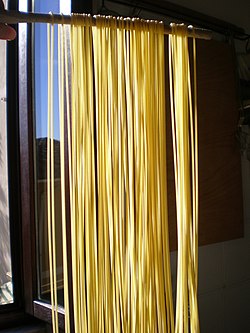Spaghetti

Spaghetti hung to dry
|
|
| Type | Pasta |
|---|---|
| Place of origin | Italy |
| Main ingredients | Semolina or flour, water |
| |
|
| Nutritional value per 1/2 cup (70 grams) | |
|---|---|
| Energy | 460 kJ (110 kcal) |
|
22g
|
|
| Sugars | 0g |
| Dietary fiber | 1g |
|
0.5g
|
|
| Saturated | 0g |
| Trans | 0g |
|
4g
|
|
| Vitamins | |
| Vitamin A equiv. |
(0%)
0 μg |
| Vitamin C |
(0%)
0 mg |
| Minerals | |
| Calcium |
(0%)
0 mg |
| Iron |
(31%)
4 mg |
| Sodium |
(0%)
0 mg |
|
Source: USDA
|
|
|
|
| Percentages are roughly approximated using US recommendations for adults. | |
Spaghetti (Italian pronunciation: [spaˈɡetti]) is a long, thin, cylindrical, solid pasta. It is a staple food of traditional Italian cuisine. Like other pasta, spaghetti is made of milled wheat and water. Italian spaghetti is made from durum wheat semolina, but elsewhere it may be made with other kinds of flour.
Originally spaghetti was notably long, but shorter lengths gained in popularity during the latter half of the 20th century and now spaghetti is most commonly available in 25–30 cm (10–12 in) lengths. A variety of pasta dishes are based on it.
Spaghetti is the plural form of the Italian word spaghetto, which is a diminutive of spago, meaning "thin string" or "twine".
The first written record of pasta comes from the Talmud in the 5th century AD and refers to dried pasta that pasta could be cooked through boiling, which was conveniently portable. Some historians think that Arabs introduced pasta to Europe during a conquest of Sicily. In the West, it may have first been worked into long, thin forms in Sicily around the 12th century, as the Tabula Rogeriana of Muhammad al-Idrisi attested, reporting some traditions about the Sicilian kingdom.
The popularity of spaghetti spread throughout Italy after the establishment of spaghetti factories in the 19th century, enabling the mass production of spaghetti for the Italian market.
In the United States around the end of the 19th century, spaghetti was offered in restaurants as Spaghetti Italienne (which likely consisted of noodles cooked past al dente, and a mild tomato sauce flavored with easily found spices and vegetables such as cloves, bay leaves, and garlic) and it was not until decades later that it came to be commonly prepared with oregano or basil.
...
Wikipedia
